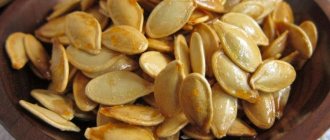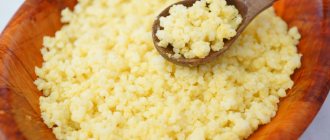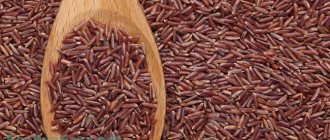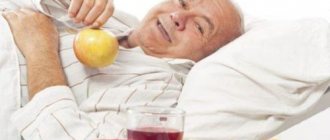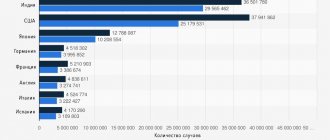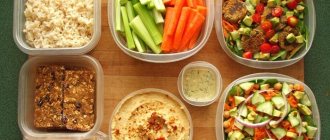Diabetes mellitus type 2 (non-insulin dependent) is a metabolic disease associated with metabolic pathologies and characterized by hyperglycemia. Sugar accumulates in the blood for several reasons: tissues ignore the transport function of the hormone insulin, as a result of which it loses the ability to accompany glucose from the blood to the cells, or there is a problem with the production of a sufficient amount of insulin by the pancreas. Therapy for the disease is based not only on the use of medications. It is generally accepted among doctors that a low-carbohydrate diet is an important component of maintaining a patient’s normal condition. In type 2 diabetes it has special features.
Fruits and vegetables for diabetics
They are divided into 3 groups:
1 group. The nutritional value of the products is up to 5 grams of carbohydrates per 100 grams of product. The following products fall under this category:
- cucumbers,
- tomatoes,
- cauliflower,
- zucchini,
- eggplants,
- salad,
- radish,
- mushrooms,
- sorrel,
- spinach,
- rhubarb,
- cranberry,
- lemon,
- pumpkin,
- apples,
- sea buckthorn,
- sour plum.
It is allowed to consume up to 600–800 grams of these products per day.
Always have some approved products on hand. If you do not have time to eat at the prescribed time or feel hungry, it is better to eat a prepared product than fast food
2nd group. The nutritional value of products ranges from 5 to 10 grams of carbohydrates per 100 grams of product. The following products fall under this category:
Low carbohydrate diet for type 2 diabetes
- carrot,
- beet,
- onion,
- swede,
- celery,
- Bell pepper,
- beans,
- tangerines,
- oranges,
- grapefruit,
- apricots,
- cherry plum,
- watermelon;
- melon,
- pear,
- peaches,
- cowberry,
- strawberries,
- raspberries,
- currant,
- blueberry,
- sweet plum.
You are allowed to consume up to 200 grams of these products per day.
Eliminate carbonated drinks from your diet. It would be best to prepare your own drink from fresh vegetables, for example, carrots, tomatoes and cucumbers
3rd group. The nutritional value of the products is more than 10 g of carbohydrates per 100 g of product. The following products fall under this category:
- potato,
- green peas),
- potatoes (sweet),
- pineapples,
- bananas,
- pomegranate,
- figs,
- cherry,
- dates,
- persimmon,
- cherries,
- grape,
- raisin,
- dried apricots,
- prunes.
For diabetics with type 2 diabetes, consumption of the above products is not recommended. You can include them in your diet if you really want to, but in limited quantities and after the approval of your doctor.
Flaws
A person who is used to eating sugar and carbohydrate foods will have a difficult time switching to the Bernstein diet. At first, a patient with diabetes may be hungry, but then the body will get used to the changes . It is most difficult for patients with kidney complications. In late-stage diabetic nephropathy, a low-carbohydrate diet is contraindicated. In 2011, an American medical school completed a study that proved that a low-carbohydrate diet can trigger the development of diabetic nephropathy. The experiment was carried out on mice.
How to make a menu correctly
When suffering from diabetes, patients are advised to adhere to the nutritional principles of “table No. 9” according to Pevzner. At first glance, it seems that the diet is strict, but it is not. Diet therapy according to table No. 9 is, first of all, a reduction in the carbohydrate component in the daily diet, while food containing protein remains normal. Meals should be provided daily in small portions. Due to excess weight in diabetics, it is recommended to eat low-calorie foods. When reducing calories, consume no more than 2300 kcal per day.
Eating in equal portions and at certain times is the path to success in treating diabetes.
You should limit your consumption of alcoholic beverages, salt and spicy foods for a number of reasons:
- Salt. It retains excess fluid in the body, which creates additional pressure on the kidneys, which are already susceptible to developing complications.
- Alcoholic drinks. Firstly, the stronger the alcohol, the more calories it contains. Secondly, alcohol-containing drinks quickly raise the level of glucose concentration in the blood vessels.
- Spicy food. Limitation of consumption is recommended due to increased appetite.
The ideal meal is considered fractional: 5-6 times a day with equal shares of proteins, fats and carbohydrates. The last meal should not be less than 2 hours before bedtime. It is recommended to schedule food consumption by day and hour. This rule is explained by the fact that the body will work for hours every day and will enter a normal rhythm.
Can I drink coffee?
The question of drinking coffee for diabetes has not yet received a clear answer. There is an assumption that caffeine improves the sensitivity of body cells to the hormone insulin. Based on this, coffee can not only be drunk if you have diabetes, but it is also necessary. In addition, the drink improves your mood, makes you feel more alert, and stimulates brain activity.
On the other hand, there is also harm:
- increased blood pressure;
- load on the heart muscle;
- powerful diuretic effect (can be quite useful);
- weakening of bone tissue;
- increased acidity levels;
- insomnia.
Thus, diabetic patients can be advised to drink one cup of weak coffee every day. At the same time, you should not put not only sugar in it, but also cream. Cinnamon would be a useful addition as it also helps lower sugar levels.
Diet for type 2 diabetes for a week
Every person wants varied and tasty food. A diabetic needs to approach this with all responsibility and intelligence so that the food is balanced and, of course, tasty.
Be creative when preparing your diet for the week, and the fight against diabetes will not be a burden for you
An example of a weekly menu (a list of dishes that you can choose is provided):
Monday
- Breakfast: oatmeal with skim milk, bran bread, tomato juice.
- Snack: milk jelly (use a sweetener for preparation), fresh or baked apples.
- Lunch: chicken soup with millet, pea soup, cucumber and tomato salad, black bread, chicken breast, green tea.
- Afternoon snack: green apple, prunes or light salad.
- Dinner: fresh white cabbage salad, buckwheat porridge with mushrooms, bran bread, boiled egg or omelet, mineral (still) water.
- Snack 2 hours before bedtime: fermented baked milk, kefir or unsweetened low-fat yogurt.
About carbohydrates
Carbohydrates are usually divided into simple, or fast, and complex, or slow. The first category includes:
- monosaccharides (glucose, fructose, galactose);
- disaccharides (sucrose, lactose, maltose).
Foods high in simple carbohydrates are confectionery, baked goods, some types of fruit, sugary drinks, etc. When they enter the body, they are quickly digested, and glucose is immediately released into the blood. Due to insulin deficiency or the inability of tissues to absorb it, hyperglycemia (increased sugar levels) develops. Fast carbohydrates are not allowed on the diabetic menu.
The second category consists of polysaccharides:
- starch (found in potatoes, bananas, pasta, some types of legumes and grains);
- glycogen (accompanies foods rich in protein);
- fiber or cellulose (the main sources are vegetables, nuts and greens);
- inulin (natural prebiotic found in onions, garlic, Jerusalem artichoke, chicory);
- pectin (predominant in vegetables, fruits, berries).
Classification of carbohydrates
Polysaccharides are absorbed by the body slowly and help maintain a feeling of fullness for a long time. They play a major role in the standard diet of diabetics. Low-carbohydrate diets are aimed primarily at reducing and stabilizing body weight. During metabolism in the liver, part of the sugar is synthesized into glycogen (glucose reserve), part is used to provide energy, and the rest is processed into fats and fat-like substances (lipids). Under the action of lipase (enzyme), fats are stored for future use, which causes weight gain.
Daily diet from Elena Malysheva
Elena Malysheva has been broadcasting about health for a long time and knows everything about the diet for type 2 diabetes. A diabetic should have breakfast before 8 am. It is better to start the day with oatmeal, and not with milk, but steamed with boiling water. You can use kefir or low-fat cottage cheese with porridge. 2 hours after breakfast, it is recommended to have a snack of boiled vegetables or unsweetened fruits. You should start having lunch no later than 12 noon. The menu includes boiled fish or meat and a salad of fresh vegetables without spicy seasonings and with a minimum amount of salt.
If desired, you can add 1-2 tablespoons of olive oil to fish or meat. The afternoon snack should be light, consisting of a glass of milk or kefir without sugar or sweeteners. Dinner must take place no later than 19:00. It is best not to load your stomach with heavy meals and eat some vegetables or fruits.
By following dietary instructions and advice, a diabetic will be able to return to normal life in a short time, while preventing the development of complications from diabetes.
Harmful foods for diabetes
They should be excluded from the diet or reduced as much as possible:
- Fast carbohydrates: semolina, rice cereals, pasta.
- Spicy, salty, fried, smoked and spicy dishes.
- Saturated fats: butter, margarine, mayonnaise, cooking and meat fats, full-fat sour cream, cream, cheeses with a fat content of more than 40%, feta cheese, sweet curd cheeses.
- Fatty and strong broths.
- Sausages, sausages, sausages, salted or smoked fish, fatty poultry, fish, meat.
Conversely, increase your consumption of fiber-rich foods.
Diet recipes
Cottage cheese casserole without semolina and flour
To prepare, you will need 250 g of cottage cheese (the cottage cheese should not be low-fat), 70 ml of milk, a couple of eggs, lemon peel, vanilla.
Method of preparation: grate the lemon peel on a fine grater, add egg yolks, cottage cheese, milk, vanilla and mix by hand with a fork or using a blender. The whites need to be cooled, beat them in a bowl until foamy, and add a little salt. Pour the egg whites into the curd mass, then pour the mixture into a mold that has been greased in advance. Bake for 30 minutes at 160 degrees.
Chicken soup with pumpkin and mint
To prepare, you will need half a kilo of pumpkin, 150 g of chicken fillet, which is the daily norm for a diabetic, 1 small onion, 50 g of cheese.
Method of preparation: peel the pumpkin and cut into small cubes. Boil the chicken fillet for 25 minutes, drain the broth at least 2 times. Cut the onion into rings. Sauté the onion and pumpkin in a frying pan. Grind the boiled fillet and mix with the stewed pumpkin, then grind it all using a blender. After the consistency has become homogeneous, pour it into the broth (since the broth is not very fatty, it can be consumed even if you have diabetes). Stir until you get a puree. Before serving dinner, add chopped cheese and mint leaves to the plate.
Adding sugar to dessert is undesirable, but is allowed in small quantities. One of the best desserts will be baked apples with cottage cheese; this is a completely dietary product.
It is important that a diabetic does not experience any dietary restrictions. Try to cook different dishes every week, or better yet, keep a food diary, and the feeling that you are fighting an illness will never visit you.
Your health depends entirely on your lifestyle and needs support. Watch your diet, eat healthy and tasty. Your doctor or nutritionist will help with this. Be healthy!
Why don't my sugar levels go down?
If the diet is balanced and takes into account prohibited foods, total calories and nutrient content, sugar levels can at least be maintained within acceptable limits. But sometimes even proper nutrition doesn’t really help. This is due to various reasons:
- no or very little physical activity;
- severe, ongoing emotional stress;
- violation of the dosage of administered insulin;
- consequences of a stroke or heart attack.
It is quite possible to control and even reduce blood glucose levels with proper nutrition. But it is important to understand that this is not the only way, so with diabetes you need to adjust your entire lifestyle, not just your diet. In addition, the patient should monitor glucose fluctuations and periodically consult a doctor for advice.
Food options
The low-carbohydrate diet for diabetics and Table No. 9 have a common basis for selecting products for the menu. The food basket is identical in quality. The difference lies in the amount of nutrients (BJU or fats, proteins, carbohydrates). In both cases, the same products are prohibited for consumption. Simple carbohydrates that are prohibited are:
- cakes, pastries, baking their butter, shortbread, puff pastry;
- candies, chocolate (milk and white);
- marshmallows, Turkish delight, marshmallows;
- ice cream, condensed milk;
- bottled tea, sweet soda, packaged juices;
- fruits: bananas, pineapples, dates, figs, grapes.
When it comes to vegetables, there are some differences in diets. With a low-calorie diet, beets, potatoes, and carrots are excluded. Table No. 9 does not prohibit these products, but strictly limits their quantity in the weekly diet. The main selection parameter is the GI (glycemic index) of the finished dish or product. This value represents the rate of food processing, the release of glucose from it and the resorption of the latter into the blood.
The lower the GI, the safer the product is for a patient with diabetes. The average glycemic index suggests limited consumption of such foods. High GI foods are prohibited. Digital indexing is as follows: low - from 0 to 30, medium - from 30 to 70, high - from 70.
Foods that diabetics should avoid
| Meat and meat products | Fatty pork, poultry (duck, goose), sausages (sausages, frankfurters, sausages), semi-finished meat products (chebureks, khinkali, dumplings), smoked deli meats, stewed meats and pates |
| Fish, fish products | Canned, salted, dried, smoked fish |
| Dairy | Full-fat cottage cheese, cheese, curd mass with additives, glazed cheese curds, sweet curd cream, sour cream and cream with a fat content of more than 10% |
| Vegetable and fruit and berry preserves | Pickled and salted vegetables (except for sauerkraut), fruits in syrup, jams, preserves |
| Cereals | White rice, sago, semolina, (couscous – limited) |
| Other categories | Fast food, fatty mayonnaise-based sauces, mustard, ketchups (all varieties) |
Any diet does not allow the use of snacks, chips, popcorn, or flavored crackers as a snack. In accordance with the listed products, the menu should not contain the following dishes: rich fatty broths and first courses prepared on their basis, milk soup with rice, smoked fish, meat, lard, pea (bean) soup with smoked meats, butter pies with sweet filling , French fries, hamburgers, cheeseburgers, etc.
With any diet, dishes prepared by the culinary method of frying are excluded from the diet. Another common feature of the two food systems is the rules for eating:
- You cannot be greedy, that is, overeat. Neither the quality of the food nor its quantity should be abused. The energy value of a one-day diet varies between 1200-1500 for a low-carbohydrate diet, 2000 for a diabetic diet according to Pevzner.
- Replace animal fats with vegetable fats. Eliminate trace fats completely.
- Follow the diet (the permissible time interval between meals is 3–4 hours). Fasting leads to a rapid decrease in blood glucose, which can result in severe hypoglycemia (even to a coma).
- Do not violate the drinking regime (approximate volume of liquid is two liters per day).
A prerequisite is permanent monitoring of glycemic indicators before and after meals
For an objective analysis of the results of the diet, it is recommended to keep a “Diary of a Diabetic”. When sugar drops extremely low, the carbohydrate component of the menu needs to be revised. A set of the right foods for a low-carbohydrate and standard diet is discussed in the table.
| Squirrels | Animals | Turkey and chicken (skinless), rabbit, fish, crab, squid, shrimp, eggs, veal (lean beef) |
| Vegetable | Nuts, mushrooms (dry, fresh) | |
| Fats | Saturated | Cow butter (limited) |
| Unsaturated | Oils: flaxseed, olive, corn, sesame | |
| Polysaccharides | Cereals | Oats, wheat, barley (barley and pearl barley), buckwheat |
| Legumes | Green and regular beans, chickpeas, beans (soy), peas, lentils |
The percentage of nutrients that is recommended to be followed:
- with a diet with limited carbohydrates BZHU = 50%, 30%, 20%
- with the diabetic ninth diet BZHU = 25%, 30%, 45%.
The fruit and vegetable component of a diabetic's menu is determined by the glycemic index. Permitted products in this category are presented in the table. To ensure that daily food intake does not cause difficulties, it is recommended to develop a diet for a week. If you can’t create a menu yourself, you can seek help from a medical specialist.
